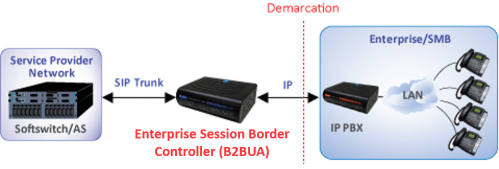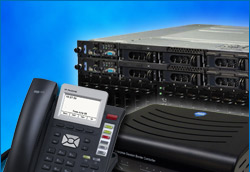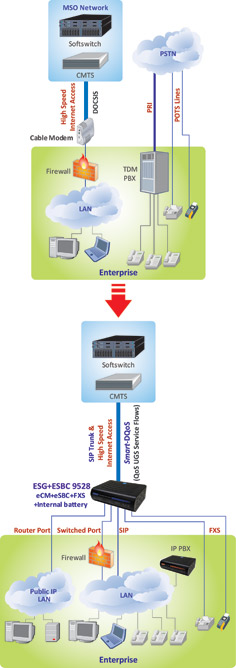ESBCs with B2BUA enabling a scalable and reliable SIP Trunking service offering.
- Signaling normalization
- Media transcoding
- Codec transcoding
- RFC2833 and in-band DTMF translation
- T.38 and G.711-fallback fax transcoding
- Carrier-grade monitoring with VoIP metrics, test agent, ladder diagrams, and call flow trace captures
- SIP Header Manipulation Rules (SHMR) for in-field header manipulation
- SIPConnect compliant and IMS ready
InnoMedia Enterprise Session Border Controllers (ESBCs) for SIP Trunking – Features and Benefits
- B2BUA for signaling normalization – Reduces SIP interoperability hurdles
- Media transcoding for media normalization – Codec transcoding, DTMF translation between RFC2833 and in-band, Fax transcoding between T.38 and G.711 fallback
- Carrier-grade monitoring utilities – VoIP metrics, SIP End-point Test Agent (SETA), ladder diagrams and WAN/LAN PCAP call flow trace captures
- SIP Header Manipulation Rules (SHMR) for in-field manipulation
- IMS ready and SIPConnect compliant
- QoS management for both Ethernet and cable interfaces
- VoIP call quality telemetry with RTCP-XR and end-of-call syslog reporting
- Highly Integrated with internal battery and optional DOCSIS 2.0/3.0 cable modem
As part of InnoMedia’s comprehensive business voice service solutions, InnoMedia’s highly manageable ESBC product family provides complete B2BUA functions for signaling normalization, and transcoding for codec/fax/DTMF media translation. These IMS-ready and SIPConnect-compliant ESBCs are ideal for service providers looking for scalable SIP trunking deployment.

Below are the InnoMedia ESBC product family feature highlights. Visit the White Papers and Application Notes in the Documentation Center to view the ESBC Product Power Point presentation for details. For more information and a comparison between SIP ALG and B2BUA operation modes, please see the InnoMedia ESBC SIP ALG and B2BUA feature comparison table.
SIP Incompatibilities and Normalization
Profile-Based SIP Normalization
SIP Header Manipulation Rules (SHMR)
Enterprise Firewall/NAT Traversal
QoS Management
Performance Monitoring
Call Monitoring and History
VoIP Call Quality Telemetry
SIP End-Point Test Agent and SIP-PRI Trace
Media Transcoding
Interoperability – SIPConnect Compliant and IMS Ready
Smart-DQoS™ and CM-ESBC Synchronization
InnoMedia’s ESBC products that support B2BUA for SIP trunking include the ESBC8328 (100BT for WAN and LAN), ESBC9328 (Gigabit Ethernet for WAN and LAN), ESBC8528 (DOCSIS 2.0 for WAN and Ethernet 100BT for LAN), ESBC9528 (DOCSIS 3.0 for WAN and Gigabit Ethernet for LAN), the media transcoding capable ESBC9378 (Gigabit Ethernet for WAN and LAN) and ESBC9578 (DOCSIS 3.0 for WAN and Gigabit Ethernet for LAN), and the PRI ESBC ESBC9380 (Gigabit Ethernet for WAN and LAN) and ESBC9580 (DOCSIS 3.0 for WAN and Gigabit Ethernet for LAN). The cable-embedded ESBCs are powered with patented Smart-DQoS™ technology for intelligent UGS service flow establishment to ensure QoS-based voice services.
| Cable Based | Ethernet Based |
| ESBC8528-4B DOCSIS 2.0 CM-based ESBC with SIP ALG and B2BUA |
ESBC8328-4B 10/100 WAN based ESBC with SIP ALG and B2BUA |
| ESBC9528-4B DOCSIS 3.0 CM-based ESBC with SIP ALG and B2BUA |
ESBC9328-4B Gigabit WAN based ESBC with SIP ALG and B2BUA |
| ESBC9578-4B DOCSIS 3.0 CM-based ESBC with SIP ALG, B2BUA, and media transcoding |
ESBC9378-4B Gigabit WAN based ESBC with SIP ALG, B2BUA, and media transcoding |
| ESBC9580-4B DOCSIS 3.0 CM-based PRI ESBC with SIP ALG and B2BUA |
ESBC9380-4B Gigabit WAN based PRI ESBC with SIP ALG and B2BUA |
| Model Name | WAN | 4LAN Ports |
4FXS ports | Internal Battery | B2BUA (SIP Trunk) |
SIP ALG (Hosted PBX) |
Transcoding | T1/PRI | QoS |
| ESBC8528-4B | DOCSIS 2.0 | 10/100BT | Yes | Yes | Yes | Yes | – | – | Smart-DQoS™ |
| ESBC9528-4B | DOCSIS 3.0 | Gigabit | Yes | Yes | Yes | Yes | – | – | Smart-DQoS™ |
| ESBC9578-4B | DOCSIS 3.0 | Gigabit | Yes | Yes | Yes | Yes | Yes | – | Smart-DQoS™ |
| ESBC9580-4B | DOCSIS 3.0 | Gigabit | Yes | Yes | Yes | Yes | – | Yes | Smart-DQoS™ |
| ESBC8328-4B | 10/100BT | 10/100BT | Yes | Yes | Yes | Yes | – | – | ToS/DSCP |
| ESBC9328-4B | Gigabit | Gigabit | Yes | Yes | Yes | Yes | – | – | ToS/DSCP |
| ESBC9378-4B | Gigabit | Gigabit | Yes | Yes | Yes | Yes | Yes | – | ToS/DSCP |
| ESBC9380-4B | Gigabit | Gigabit | Yes | Yes | Yes | Yes | – | Yes | ToS/DSCP |
| InnoMedia ESBC Advantages | ||
|---|---|---|
| Highest Level of Integration | eCM, eSBC, FXS, Internal batteries, PRI | |
| Advanced DOCSIS 3.0 | 8×4 channel bonding, 24 UGS SIDs for 24 QoS service flows | |
| Complete Session Border Control features | • | B2BUA and Registrar for SIP trunk, SIP ALG for hosted PBX, |
| • | NAT traversal, SIP normalization, IMS ready, SIPConnect compliant | |
| • | DTMF transcoding (ESBC 9580/9380), Emergency Calling support | |
| QoS | • | Smart-DQoS™ for Cable – ESBC monitors and intelligently sets up service flows for SIP trunks, IP Centrex, and FXS lines to ensure QoS |
| • | VLAN & TOS/DSCP for Ethernet | |
| Business Line features | • | Ground start/loop start and CPC/Open Loop Disconnect → Key Phone Systems/Analog PBXs |
| • | Low-speed modem → Credit card reader | |
| • | Fax with T.38 | |
| Complete with carrier-grade monitoring | ESBC VoIP Performance Metrics → RTCP-XR and end-of-call syslog reporting: | |
| • | Voice quality: R-factor, MOS scores | |
| • | Network performance: Delay, packet loss, jitter | |
| Element Management System (EMS) for device status monitoring, event reporting, remote access for device diagnostics, and VoIP performance metrics display and analysis | ||
|
ESBC Features and Benefits
|
|||||
| Functional Blocks/Categories | Features | Benefits | |||
| High-Speed WAN I/F | Embedded Cable Modem: | DOCSIS 3.0 embedded cable modem: | |||
| 1. | ESBC 9528/9580: DOCSIS 3.0 with 8×4 channel bonding and 24 UGS SIDs |
1. | 300 Mbps downstream and 120 Mbps upstream BW | ||
| 2. | ESBC 8528: DOCSIS 2.0 | 2. | 24 UGS SIDs for 24 DQoS-ensured voice sessions | ||
| Ethernet Interface: | |||||
| 1. | ESBC 9380/9328: Gigabit Ethernet | ||||
| 2. | ESBC 8328: 10/100 BT Ethernet | ||||
| Quality of Service | QoS: | Smart-DQoS™: | |||
| 1. | WAN: Smart-DQoS™ for ESBC 9580/9528/8528 | Device-initiated DQoS UGS service flows ensure QoS for voice sessions | |||
| 2. | VLAN/DSCP for ESBC 9380/9328/8328 | a. | Instant service quality improvement | ||
| 3. | LAN: VLAN with 1000 groups | b. | Minimum infrastructure investment | ||
| c. | Time to market acceleration | ||||
| Embedded Session Border Controller (eSBC) |
Registrar and B2BUA | • Highly interoperable between service provider and enterprise equipment | |||
| 1. | Implicit, explicit, and static (no) registration | • No interference with enterprise firewall setting | |||
| 2. | Header manipulation/SIP normalization | • Reliable and scalable SIP trunking service delivery | |||
| 3. | NAT traversal | ||||
| 4. | SIPConnect compliant | ||||
| 5. | IMS ready | ||||
| SIP ALG | • | Highly interoperable between service provider and enterprise equipment | |||
| 1. | Header manipulation | • | No interference with enterprise firewall setting | ||
| 2. | NAT traversal | • | Reliable and scalable hosted PBX/IP Centrex service delivery | ||
| 3. | SIPConnect compliant | ||||
| 4. | IMS ready | ||||
| High-speed bridge port | Transparent Gigabit data port | High-speed Internet data service delivery | |||
| FSX commercial voice ports | Four FXS ports with commercial line features | Business Friendly | |||
| 1. | T.38 | 1. | Analog PBX interconnect | ||
| 2. | Low-speed (high-speed) modems | 2. | Fax | ||
| 3. | House wiring | ||||
| 4. | Credit card reader | ||||
| PRI ports (ESBC 9580/9380 only) | 1. | Support multiple switch types: 4ESS, 5ESS, NI1, NI2, Q.SIG, EuroISDN | Supporting both TDM PRI PBX and SIP UA (IPPBX), extending SIP trunking services to TDM customers. Allowing co-existence of TDM and IP, or transitioning from TDM to IP. Highly interoperable with different switch types, media formats, and signaling variations. |
||
| 2. | Media processing: DTMF transcoding, Codec transcoding, echo cancellation | ||||
| 3. | Interoperability: | ||||
| a. | Ringback via ISDN alerting or B channel | ||||
| b. | Caller name discard option | ||||
| Internal battery | 4 hours of talk time | Power backup for primary line services | |||
| Security Features | 1. | Stateful inspection | 1. | No intrusion into enterprise networks via SIP path | |
| 2. | TLS for signaling | 2. | Secured signaling | ||
| 3. | Access control | ||||
| Performance Monitoring and Management | 1. | VoIP performance metrics | Allowing service providers to offer Service Level Agreement (SLA) based 1st tier quality services to enterprise customers | ||
| a. | Voice: R-factor & MOS scores | ||||
| b. | Network: jitter, delay, packet loss | ||||
| 2. | CDR records | ||||
| 3. | SIP End-point Test Agent | ||||
| • | Manual test calls | ||||
| • | Pre-scheduled calls | ||||
| • | Call performance reporting | ||||
| 4. | SNMP traps for quality alarms | ||||
| Emergency call handling | 1. | Line pre-emption | Allowing service providers to offer SIP trunking services with Emergency calling support for primary line based services | ||
| 2. | SIP signaling | ||||
| a. | Emergency caller ID | ||||
| b. | Priority header | ||||
| 3. | Media: | ||||
| a. | G.711 | ||||
| b. | Disable VAD | ||||
| 4. | QoS | ||||
| a. | DQoS pre-emption | ||||
| b. | DiffServ | ||||
| 5. | Syslog and SNMP trap | ||||










